|
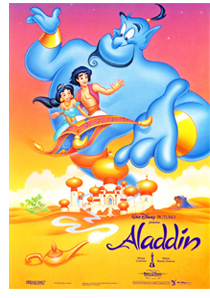 It
is easy to forget the moribund state of feature-length animation
before the 1989 release of The Little Mermaid. Beauty and the Beast
kept the revival going and, with Aladdin, Disney proved that the
animated film's resurgence was no fluke. Composer and lyricist Alan
Menken rubbed his magic lamp once again to produce a toe-tapping (and
Oscar-winning) score, including the radio-friendly A Whole New World.
But if any one person can be credited with Aladdin's success, it is
Robin Williams. With one-liners galore and imitations of everyone
from William F. Buckley to Arsenio Hall, Williams' manic (what else?)
genie is a comic whirlwind with an animated body that can keep up
with the real thing's boundless energy. Not every joke in Aladdin
hits, but more than a few adults were surprised to find themselves
laughing harder than the little ones they brought in tow. The film
falls a little short of the high mark set by its two predecessors, as
its plotting and lead characters are somewhat more conventional. And
not all viewers felt that Disney's foray into ethnic diversity was
without stereotyping. But overall, Aladdin once again proved the
Disney magic for creating an animated film worth watching with or
without the kids. It
is easy to forget the moribund state of feature-length animation
before the 1989 release of The Little Mermaid. Beauty and the Beast
kept the revival going and, with Aladdin, Disney proved that the
animated film's resurgence was no fluke. Composer and lyricist Alan
Menken rubbed his magic lamp once again to produce a toe-tapping (and
Oscar-winning) score, including the radio-friendly A Whole New World.
But if any one person can be credited with Aladdin's success, it is
Robin Williams. With one-liners galore and imitations of everyone
from William F. Buckley to Arsenio Hall, Williams' manic (what else?)
genie is a comic whirlwind with an animated body that can keep up
with the real thing's boundless energy. Not every joke in Aladdin
hits, but more than a few adults were surprised to find themselves
laughing harder than the little ones they brought in tow. The film
falls a little short of the high mark set by its two predecessors, as
its plotting and lead characters are somewhat more conventional. And
not all viewers felt that Disney's foray into ethnic diversity was
without stereotyping. But overall, Aladdin once again proved the
Disney magic for creating an animated film worth watching with or
without the kids.
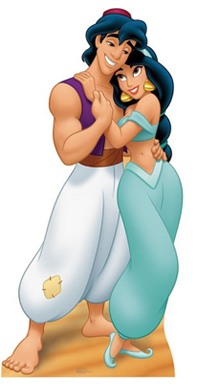 Aladdin
was released on November 25, 1992 to positive reviews, despite some
criticism from Arabs who considered the film racist, and was the most
successful film of 1992, earning over $217 million in revenue in the
United States, and over $504 million worldwide. The film also won
many awards, most of them for its soundtrack. Aladdin's success led
to many material inspired by the film such as two direct-to-video
sequels, The Return of Jafar and Aladdin and the King of Thieves, an
animated television series, toys, video games, spin-offs, and merchandise. Aladdin
was released on November 25, 1992 to positive reviews, despite some
criticism from Arabs who considered the film racist, and was the most
successful film of 1992, earning over $217 million in revenue in the
United States, and over $504 million worldwide. The film also won
many awards, most of them for its soundtrack. Aladdin's success led
to many material inspired by the film such as two direct-to-video
sequels, The Return of Jafar and Aladdin and the King of Thieves, an
animated television series, toys, video games, spin-offs, and merchandise.
In 1988, lyricist Howard
Ashman pitched to Disney the idea of an animated musical adaptation
of Aladdin. After Ashman wrote some songs with partner Alan Menken
and a film treatment, a screenplay was written by Linda Woolverton,
who had worked on Beauty and the Beast. Then directors John Musker
and Ron Clements joined the production, picking Aladdin out of three
projects offered, which also included an adaptation of Swan Lake and
King of the Jungle - that eventually became The Lion King. Musker and
Clements wrote a draft of the screenplay, and delivered it to studio
chief Jeffrey Katzenberg in 1991. Katzenberg thought the script
"didn't engage", and only approved it after the
screenwriting duo Ted Elliott and Terry Rossio rewrote it. Among the
changes, the character of Aladdin's mother was removed, Princess
Jasmine was made into a stronger character, Aladdin's personality was
rewritten to be "a little rougher, like a young Harrison Ford, 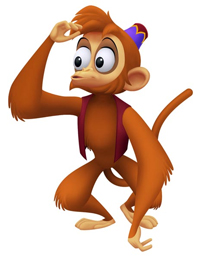 and
the parrot Iago, originally conceived as a "British" calm
and serious character, was reworked into a comic role after the
filmmakers saw Gilbert Gottfried in Beverly Hills Cop II. Gottfried
was cast to provide Iago's voice. Several characters and plot
elements are also based on the 1940 version of The Thief of Bagdad,
and many aspects of the traditional story were changed for the film
— for instance, the setting is changed from "China" to
a fictional Arabian city, Agrabah. Elements from the story Ma'aruf
the Cobbler and his Wife Fatimah, another story from One Thousand and
One Nights, were also added in, with the final result being a blend
of the original two stories. and
the parrot Iago, originally conceived as a "British" calm
and serious character, was reworked into a comic role after the
filmmakers saw Gilbert Gottfried in Beverly Hills Cop II. Gottfried
was cast to provide Iago's voice. Several characters and plot
elements are also based on the 1940 version of The Thief of Bagdad,
and many aspects of the traditional story were changed for the film
— for instance, the setting is changed from "China" to
a fictional Arabian city, Agrabah. Elements from the story Ma'aruf
the Cobbler and his Wife Fatimah, another story from One Thousand and
One Nights, were also added in, with the final result being a blend
of the original two stories.
The design for most
characters was based on the work of caricaturist Al Hirschfeld, which
production designer Richard Vander Wende also considered appropriate
to the theme, due to similarities to the swooping lines of Persian
miniatures and Arabic calligraphy. Jafar's design was not based on
Hirschfeld's work because Jafar's supervising animator, Andreas Deja,
wanted the character to be contrasting. Each character was animated
alone, with the animators consulting each other to make scenes with
interrelating characters. Since Aladdin's animator Glen Keane was
working in the California branch of Walt Disney Feature Animation,
and Jasmine's animator Mark Henn was in the Florida one at Disney-MGM
Studios, they had to frequently phone, fax or send designs and discs
to each other.
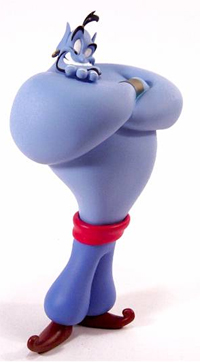 Musker
and Clements created the Genie with Robin Williams in mind; even
though Katzenberg suggested actors such as John Candy, Steve Martin,
and Eddie Murphy, Williams was approached and eventually accepted the
role. Williams came for voice recording sessions during breaks in the
shooting of two other films he was starring in at the time, Hook and
Toys. Unusually for an animated film, much of Williams' dialogue was
ad-libbed: for some scenes, Williams was given topics and dialogue
suggestions, but allowed to improvise his lines. It was estimated
that Williams improvised 52 characters. Eric Goldberg, the
supervising animator for the Genie, then reviewed Williams' recorded
dialogue and selected the best gags and lines that his crew would
create character animation to match. Musker
and Clements created the Genie with Robin Williams in mind; even
though Katzenberg suggested actors such as John Candy, Steve Martin,
and Eddie Murphy, Williams was approached and eventually accepted the
role. Williams came for voice recording sessions during breaks in the
shooting of two other films he was starring in at the time, Hook and
Toys. Unusually for an animated film, much of Williams' dialogue was
ad-libbed: for some scenes, Williams was given topics and dialogue
suggestions, but allowed to improvise his lines. It was estimated
that Williams improvised 52 characters. Eric Goldberg, the
supervising animator for the Genie, then reviewed Williams' recorded
dialogue and selected the best gags and lines that his crew would
create character animation to match.
The producers added many
in-jokes and references to Disney’s previous works in the film,
such as a "cameo appearance" from directors Clements and
Musker and drawing some characters based on Disney workers. Beast,
Sebastian from The Little Mermaid, and Pinocchio make brief
appearances, and the wardrobe of the Genie at the end of the film -
Goofy hat, Hawaiian shirt, and sandals - are a reference to a short
film that Robin Williams did for the Disney/MGM Studios tour in the
late 80s.
In gratitude for his
success with the Disney/Touchstone film Good Morning, Vietnam, Robin
Williams voiced the Genie for SAG scale pay ($75,000), on condition
that his name or image not be used for marketing, and his
(supporting) character not take more than 25% of space on advertising
artwork, since Toys was scheduled for release one month after
Aladdin's debut. For financial reasons, the studio went back on the
deal on both counts, especially in poster art by having the Genie in
25% of the image, but having other major and supporting characters
portrayed considerably smaller. The Disney Hyperion book Aladdin: The
Making Of An Animated Film, listed both of Williams' characters
"The Peddler" and "The Genie" ahead of main
characters, but was forced to refer to him only as "the actor
signed to play the Genie".
Williams and Disney had a
bitter falling-out, and as a result, Dan Castellaneta voiced the
Genie in The Return of Jafar, the Aladdin animated television series,
and had recorded his voice for Aladdin and the King of Thieves. When
Jeffrey Katzenberg was fired from Disney and replaced by former 20th
Century Fox production head Joe Roth (whose last act for Fox was
greenlighting Williams' film Mrs. Doubtfire), Roth arranged for a
public apology to Williams by Disney. Williams agreed to perform in
Hollywood Pictures' Jack, directed by Francis Ford Coppola, and even
agreed to voice the Genie again for the King Of Thieves sequel (for
considerably more than scale), replacing all of Castellaneta's dialogue.
|
|
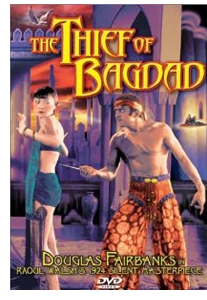 The
story of Aladdin concerns an impoverished young man who is recruited
by a sorcerer to retrieve a wonderful oil lamp from a booby-trapped
magic cave. After the sorcerer attempts to double-cross him, Aladdin
keeps the lamp for himself, and discovers that it summons a surly
djinn that is bound to do the bidding of the person holding the lamp.
With the aid of the djinn, Aladdin becomes rich and powerful and
marries princess Badroulbadour. The sorcerer returns and is able to
get his hands on the lamp by tricking Aladdin's wife, who is unaware
of the lamp's importance. The
story of Aladdin concerns an impoverished young man who is recruited
by a sorcerer to retrieve a wonderful oil lamp from a booby-trapped
magic cave. After the sorcerer attempts to double-cross him, Aladdin
keeps the lamp for himself, and discovers that it summons a surly
djinn that is bound to do the bidding of the person holding the lamp.
With the aid of the djinn, Aladdin becomes rich and powerful and
marries princess Badroulbadour. The sorcerer returns and is able to
get his hands on the lamp by tricking Aladdin's wife, who is unaware
of the lamp's importance.
Aladdin discovers a lesser,
polite djinn is summoned by a ring loaned to him by the sorcerer but
forgotten during the double-cross. Assisted by the lesser djinn,
Aladdin recovers his wife and the lamp. The theme of a trickster
being outwitted by another trickster of lowly birth is a widespread
motif in fables.
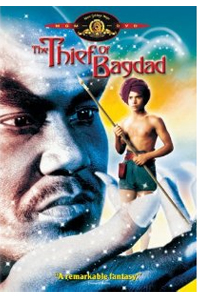 The
story of Aladdin is a classic example of one of the seven basic
plots in story-telling i.e. an example of the
"rags-to-riches" story. This type of story presents in
three parts: from lowly beginnings, a protagonist achieves an initial
success in life, traverses a major crisis in which all seems lost,
and finally triumphs over adversity to achieve more stable and
enduring success. This final success is only possible because the
hero has learned a degree of inner maturity by going through the crisis. The
story of Aladdin is a classic example of one of the seven basic
plots in story-telling i.e. an example of the
"rags-to-riches" story. This type of story presents in
three parts: from lowly beginnings, a protagonist achieves an initial
success in life, traverses a major crisis in which all seems lost,
and finally triumphs over adversity to achieve more stable and
enduring success. This final success is only possible because the
hero has learned a degree of inner maturity by going through the crisis.
Aladdin's first success
came too easily and was not based on his own efforts, but the genie's
who helped him; his despair at losing the princess and the palace to
the evil sorcerer takes him to a spiritual place at which he needs to
arrive before he can develop true strength and wholeness by making
his own efforts to succeed. The wholeness he finally achieves is
symbolised by the re-establishment of the relationship with the
princess. One of the reasons for the enduring interest of the Aladdin
story lies in our often unconscious recognition of the importance of
its underlying meaning. We recognize our own struggles to grow and
develop in Aladdin's journey.
The original full text
episode, usually omitted in the bowdlerized versions, in which the
naïve Aladdin is cheated and exploited by a treacherous Jewish
merchant, and is saved by the Jew's honest and upright Muslim
competitor. The late Dr. Yoel Yosef Rivlin who translated the book
into Hebrew admitted that although he had a feeling of distaste and
felt apprehension that his full translation might ruin an otherwise
delightful tale for Israeli readers, he still felt duty-bound to
provide Hebrew readers with a full and unexpurgated translation. |